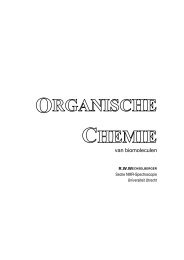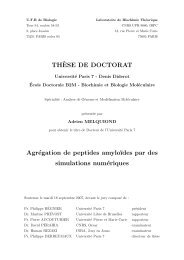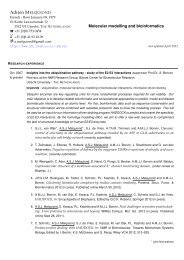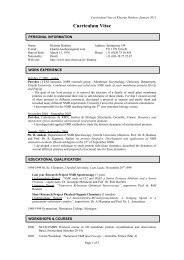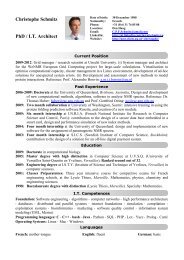Thesis Title: Subtitle - NMR Spectroscopy Research Group
Thesis Title: Subtitle - NMR Spectroscopy Research Group
Thesis Title: Subtitle - NMR Spectroscopy Research Group
You also want an ePaper? Increase the reach of your titles
YUMPU automatically turns print PDFs into web optimized ePapers that Google loves.
4 Chapter 1. Introduction.<br />
In contrast to NOE or 3 J coupling effects that are short-range (measureable for distance<br />
below 6 Å) and local (each measurement concerns an independent group of atoms), paramagnetic<br />
<strong>NMR</strong> introduces new effects that are long-range (measured up to 40 Å), and global (i.e. their effect<br />
is described for all spins in a common frame centered on the paramagnetic lanthanide).<br />
1.2 Paramagnetic <strong>NMR</strong><br />
1.2.1 The four paramagnetic effects in <strong>NMR</strong><br />
When a paramagnetic centre with unpaired electrons, such as a lanthanide ion, is present in<br />
a protein, the observed <strong>NMR</strong> spectrum changes due to induced paramagnetic effects. By<br />
comparison of the diamagnetic and paramagnetic spectra, one can observe the following four<br />
paramagnetic effects:<br />
The pseudocontact shift (PCS): It is given by equation (1.1), where the spin of interest is<br />
described by its polar coordinate in an internal frame (the Δχ-tensor frame) centered on the<br />
paramagnetic center (Figure 1.2.a).<br />
(1.1)<br />
Δχax = χz – (χz + χy)/2 and Δχrh = (χx - χy) are respectively the axial and rhombic component<br />
that describe the anisotropic effect; r, θ and θ are the polar coordinate of the spin in the Δχ-tensor<br />
frame (Figure 1.2.a). The PCS is a long range effect (up to 40 Å) which decays with 1/r 3 , and is<br />
measured as the difference between the paramagnetic and diamagnetic chemical shift (Figure 1.3).<br />
The residual dipolar coupling (RDC): With an attached paramagnetic lanthanide, a<br />
protein weakly aligns with respect to the magnetic field. RDCs are manifested as increases or<br />
decreases of the magnitudes of multiplet splittings that can be observed in undecoupled <strong>NMR</strong><br />
spectra (Figure 1.3). The RDC can also be back-calculated (equation (1.2)) provided that the<br />
orientation of the two spins with respect to the alignment tensor is known (Figure 1.2.b).<br />
with:<br />
(1.2)



